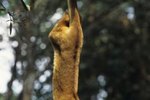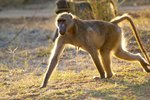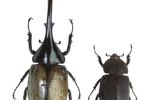
Anteaters are a family of four different species that can be found throughout Central and South America. Their sizes and behavior vary widely, but all anteaters have a prehensile tail that aids them in climbing trees and long, tubular snout from which their tongue darts out to consume anywhere from 100 to 8,000 ants per day.
Silky Anteater
Cyclopes, commonly referred to as the silky anteater, can be found in the forests of southern Mexico, Bolivia and Brazil. The smallest of the four anteater species weighs just 9.37 ounces and rarely descends from the ceiba tree, where it disguises itself among silky fibers that grow from the trees' pods. Because their fur blends in so well with these fibers, the silky anteater is able to avoid being attacked by large birds of prey. Due to their reclusive nature, little is known about the silky anteater's behavior.
Northern Tamandua
Tamandua mexicana, or the northern tamandua, can be found all throughout Central and South America, particularly in parts of southeastern Mexico, west of the Andes, and northern Venezuela and Peru. They are foragers who live in a variety of habitats but prefer lush forests with streams and vines, due to the large populations of ants and termites in those areas. This anteater's tongue can extend to 40 centimeters, and their fur is white with a distinctive black marking on the chest that resembles a furry vest. Like another distinctively marked black-and-white creature, northern tamanduas produce an extremely unpleasant misty aroma from their anal glands when threatened by predators.
Southern Tamandua
The southern tamandua, Tamandua tetradactyla, is the second largest of the anteaters, reaching up to 1.5 meters in length. This animal can be found only in South America, in the countries of Venezuela, Trinidad, Argentina, Brazil and Uruguay. Like its northern cousin, the southern tamandua prefers to inhabit areas thick with trees and streams, where colonies of ants and termites are plentiful. Their coloring can range from a light sand to dark brown, and may share similar "vest" markings like the northern tamandua. These anteaters actually prefer termites as their main form of food, and use their clawed digits to break into colonies for a tasty snack.
Giant Anteater
The most famous of anteaters is Myrmecophaga tridactyla -- the giant anteater -- found all over Central and South America. Its snout can grow up to 45 centimeters in length, while its body may be up to 1.2 meters and its tail might be nearly as long as its body. Their tongues dart in and out of their mouths at up to 150 times per minute, and their large size allows them to consume thousands of insects within just a few minutes. While giant anteaters have very few natural predators, humans may pose a threat through hunting or automobile accidents.
References
- The University of Edinburgh: Anteaters
- Animal Diversity Web; Cyclopes didactylus: Megan Schober
- Animal Diversity Web; Tamandua mexicana: Andria Harrold
- San Diego Zoo Animals: Tamandua
- Animal Diversity Web; Tamandua tetradactyla: Antonia Gorog
- World Association of Zoos and Aquariums: Southern Tamandua
- Animal Diversity Web; Myrmecophaga tridactyla: Amy Woltanski
Photo Credits
-
Anup Shah/Photodisc/Getty Images
Writer Bio
Margot Freeman has been a writer since 2009. She currently works in social media within the tech industry, and has been volunteering with acclaimed Austin, Texas animal shelter Austin Pets Alive! since 2010. Freeman holds a Bachelor of science in audio and media technology.



